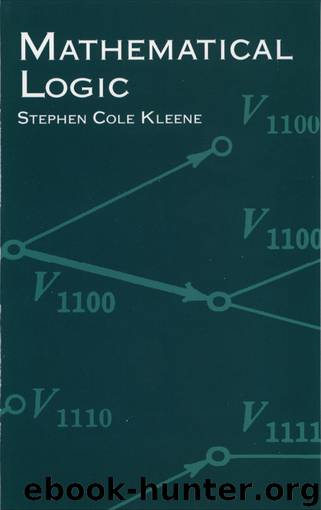Mathematical Logic by Stephen Cole Kleene

Author:Stephen Cole Kleene
Language: eng
Format: epub
Publisher: Dover Publications, Inc.
Published: 1967-06-26T16:00:00+00:00
* § 39.Some other formal systems. In this section, we give further examples [2]-[50] of formal systems (where [1] is the system N of §38).
We now describe [2] a system G, which formalizes the elementary theory of an unspecified “group” (explanation follows).
The formal symbols shall be
Variables are to be constructed as in § 38 for N. (The only difference in the formation rules between N .and G is that + ,·, ′ , 0 are replaced by · -1 , 1 .)
DEFINITION OF “TERM”. 1. 1 is a term. 2. The variables . . . are terms. 3-4. If r is a term, so are (r)·(s) and (r)-1. 5. The only terms are those given by 1-4.
Given this definition of “term”, the definition of “formula” from “term” reads as in § 38.
Parentheses are omitted under the same conventions as there. Furthermore (as we could also have done in § 38), we shall abbreviate r·s (i.e. (r).(s)) as “rs” (omitting the dot).
As postulates, we take those of the predicate calculus, with the present notions of “term” and “formula” (§§ 21,28); just as for N, the r for the ∀-schema and the ∃-schema can be any term free for x in A(x). In addition, there shall be the following six particular axioms:
El.. . .
Gl. (Associative law.)
G2.(Right identity.)
G3.(Right inverse of .)
We do not intend a single interpretation of this formal system G, as we did of N. The system G may be interpreted by any “group” G, as we shall explain and illustrate in a moment. For any choice of a “group” G, the terms are interpreted as naming members (specified or unspecified) of G (or more precisely of G0, below).
Axioms E1-E3 give what we need to postulate of the properties of equality (identity).158
The axioms G1-G3 for groups will be familiar to many students. A group G is briefly any “system” of objects which “satisfies” these three axioms (with the variables in the generality interpretation §§ 20,38, and with = expressing “identity” or “equality”§ 29).
That is, a group G consists of a nonempty set G0, a 2-place function a.b with arguments and values in G0, a 1-place function a-1 with arguments and values in G0, and a member of G0 (or 0-place function) 1, such that the closures of G1-G3 are all t in our model theory of the predicate calculus with equality § 29 when G0 is the domain and a·b, a-1, 1 are the values of · , -1, l. 159
To give only a few particular interpretations, G can be (1) the positive rational numbers with ·, -1, 1 having their usual meanings. (The student should have no trouble verifying that G1-G3 are satisfied by each of our interpretations.) Alternatively, G can be (2) the rational numbers except 0, (3) the positive real numbers, (4) the real numbers except 0, or (5) the complex numbers except 0, with ·, -1, 1 in their usual meanings. Still again, G can be (6) all the integers, (7) all the rational numbers, (8) all
Download
This site does not store any files on its server. We only index and link to content provided by other sites. Please contact the content providers to delete copyright contents if any and email us, we'll remove relevant links or contents immediately.
| Algebra | Calculus |
| Combinatorics | Discrete Mathematics |
| Finite Mathematics | Fractals |
| Functional Analysis | Group Theory |
| Logic | Number Theory |
| Set Theory |
Modelling of Convective Heat and Mass Transfer in Rotating Flows by Igor V. Shevchuk(6352)
Weapons of Math Destruction by Cathy O'Neil(6080)
Factfulness: Ten Reasons We're Wrong About the World – and Why Things Are Better Than You Think by Hans Rosling(4622)
Descartes' Error by Antonio Damasio(3186)
A Mind For Numbers: How to Excel at Math and Science (Even If You Flunked Algebra) by Barbara Oakley(3185)
Factfulness_Ten Reasons We're Wrong About the World_and Why Things Are Better Than You Think by Hans Rosling(3161)
TCP IP by Todd Lammle(3098)
Applied Predictive Modeling by Max Kuhn & Kjell Johnson(2981)
Fooled by Randomness: The Hidden Role of Chance in Life and in the Markets by Nassim Nicholas Taleb(2971)
The Tyranny of Metrics by Jerry Z. Muller(2953)
The Book of Numbers by Peter Bentley(2875)
The Great Unknown by Marcus du Sautoy(2611)
Once Upon an Algorithm by Martin Erwig(2541)
Easy Algebra Step-by-Step by Sandra Luna McCune(2540)
Lady Luck by Kristen Ashley(2495)
Practical Guide To Principal Component Methods in R (Multivariate Analysis Book 2) by Alboukadel Kassambara(2447)
Police Exams Prep 2018-2019 by Kaplan Test Prep(2441)
All Things Reconsidered by Bill Thompson III(2327)
Linear Time-Invariant Systems, Behaviors and Modules by Ulrich Oberst & Martin Scheicher & Ingrid Scheicher(2304)
